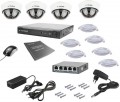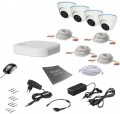Recorder
This parameter refers to the included DVR and describes the types of video signal (and therefore cameras) with which it is compatible. In some cases, the model is also indicated - for connoisseurs of the matter. So you can learn more about the capabilities of the device on specialized sources.
-
Analog. Recorders capable of working only with analog cameras, usually connected via the BNC interface (see below). The functionality of such devices is less extensive than in digital and hybrid models, but they are simple, inexpensive and quite capable of coping with basic video surveillance tasks. We also note that a modern analog recorder usually has video outputs and service interfaces in a digital format - primarily HDMI and LAN (see below).
-
Digital. Recorders designed to work with IP cameras - that is, cameras that transmit video signal through computer networks. This signal format provides improved noise immunity and a greater number of additional features compared to analog. In addition, it allows you to build video surveillance systems based on existing local networks, and cameras can be connected not only by wire, but also wirelessly (see below for more details). On the other hand, digital recorders and cameras are more expensive than analog ones, advanced functionality is not often needed in practice, and the transfer of a large number of video streams can create a high load on net
...work equipment. Therefore, it makes sense to purchase such a recorder only if the described advantages have crucial.
- Hybrid. Recorders that combine the capabilities of analog and digital models - that is, compatible with both analog and IP cameras. This combination allows you to combine the advantages of both types and partly compensate for the shortcomings, but significantly increases the price of the registrar.Video channels
The number of video channels that the set's recorder is capable of simultaneously processing. In fact, this is the number of cameras that the device can simultaneously work with; it is technically possible to connect more cameras, but this will require additional equipment — such as quadrators.
The choice for this parameter depends on how extensive and extensive the observation system is planned to be built. At the same time, it should be noted that modern technologies allow combining several registrars into a system with a single control; therefore, for numerous cameras, it is sometimes easier to purchase several relatively modest kits than one multi-channel one.
Camera model
A model of dome cameras supplied as standard with a video surveillance kit. Knowing this data, you can find detailed information on the cameras and clarify their characteristics. In addition, by purchasing additional cameras of the same model, you don't have to worry about compatibility.
Matrix size
The physical size of the sensor in the complete dome cameras is diagonally, in inches (fractions of an inch).
The larger the sensor, the less prone it is to noise, the better image quality it can provide, and the better it is suited to low light conditions. This is due to the fact that each individual pixel gets more light, because. on a large matrix and individual dots are larger. On the other hand, large matrices are more expensive.
Focal length
Focal length of the dome camera lens included in the kit.
The focal length is the distance between the lens and the matrix, at which the image on the sensor is as clear as possible (when the lens is focused to infinity). This indicator directly affects the viewing angles and the degree of magnification: the larger the focal length, the narrower the viewing angle and the more the camera "brings" the object. At the same time, it should be noted that the actual viewing angle is determined not only by the focal length, but also by the size of the matrix (see above). In fact, this means that with different sizes of matrices, lenses with the same focal length will have different working angles. Therefore, only cameras with the same matrix size can be compared with each other according to this indicator.
PoE power
Ability to power IP cameras from the registrar, using
PoE technology.
This technology (Power over Ethernet) allows you to supply power to external network devices over a LAN cable. Simply put, each camera will be able to receive power through the same wire through which it transmits the video signal to the recorder. This eliminates the hassle of separate power supplies. For PoE to work, it must be supported by both the recorder and the cameras; however, this is what is usually provided for in video surveillance kits.
BNC video input
The number of
BNC video inputs provided in the design of the complete registrar.
BNC is a standard coaxial cable interface used to transmit analogue video signal in video surveillance systems; accordingly, it is found only in analogue and hybrid sets (see "Type"). The number of BNC connectors usually corresponds to the number of analogue video channels supported by the DVR.
RCA audio input
The number of
RCA audio inputs provided in the design of the complete recorder.
The presence of such connectors allows the recorder to receive an analogue audio signal from cameras that have the ability to capture sound, or from separately made microphones. It is worth looking for a set with such capabilities in cases where it is critical to record not only the picture, but also the sound during observation. Note that the number of RCA inputs may correspond to the number of BNC connectors (see above), but may be less.
Frame rate
The highest frame rate at which the complete recorder can record at full load when all video channels are used. In other words, this is the guaranteed maximum frame rate that can be achieved at any load level (with some channels idle, the number of frames per second may be higher, but not necessarily).
The higher the frame rate, the better fast movement will be captured, the less blurry objects in such scenes will turn out. On the other hand, this indicator directly affects the cost of equipment and the amount of memory occupied by the footage. For video surveillance systems, an indicator of 24 fps is currently considered the minimum necessary, 50 – 60 fps is not bad, and in the most advanced registrars this number can reach 120 fps.

